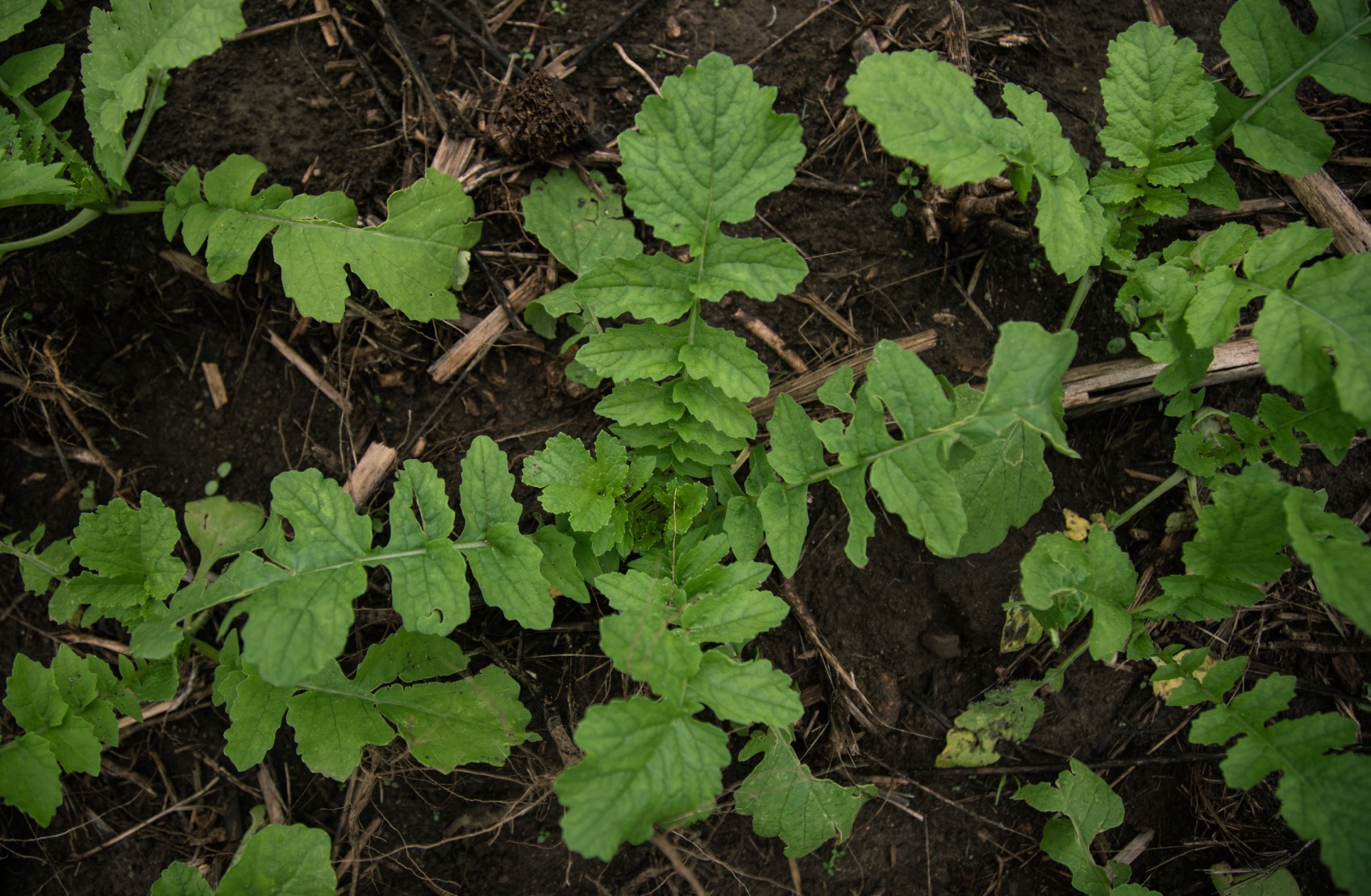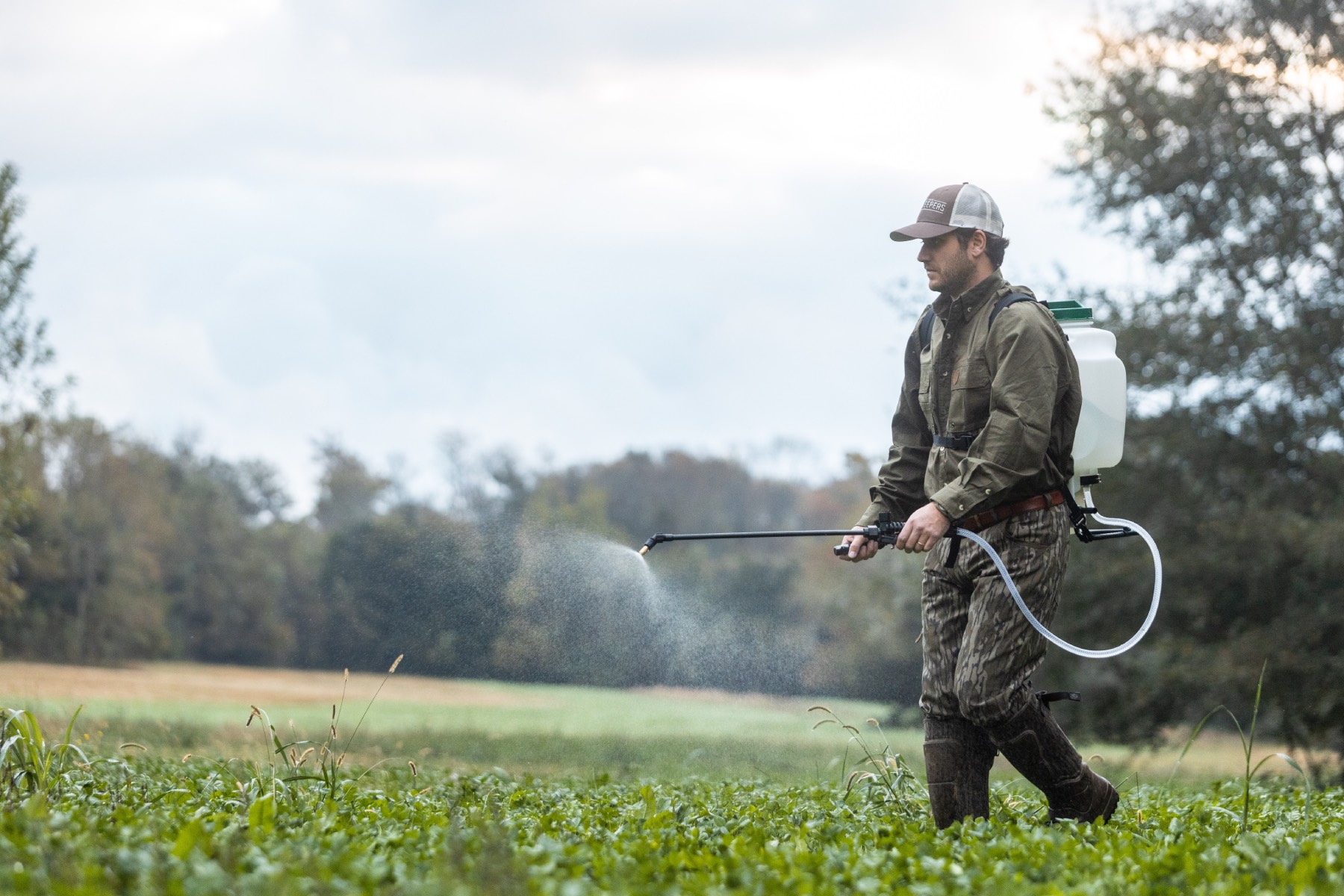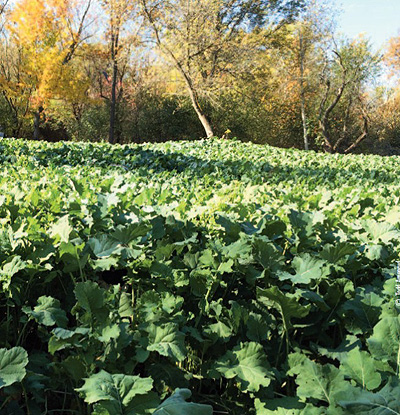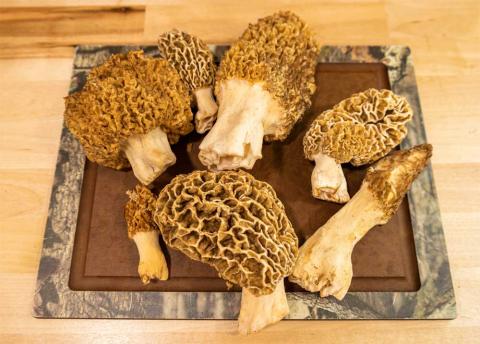Gerald Almy | Originally published in GameKeepers: Farming for Wildlife Magazine. To subscribe, click here.
Did you ever take a zinc pill to help reduce the intensity of a cold or a multivitamin with iron? Those are small examples of the role micronutrients can play in our life. Actually, you need that zinc whether you’re getting a cold or not, we need it simply to exist. You also need the iron, as well as other elements such as copper, calcium and manganese.
Micronutrients are vital for all life forms including humans, deer, turkeys and the soybeans, brassicas, and oats we grow to feed the animals on our land. The need for micronutrients in your food plots is where we’re focusing today. Because when the plants we grow have sufficient amounts of them, those nutrients are in turn absorbed by the deer that consume them.
A micronutrient is a nutrient or trace mineral only needed by living things in small quantities. Besides true micronutrients, though, we’ll also look at a few other similar elements deer require that are sometimes overlooked such as magnesium, calcium, and sulfur.

You can give deer micronutrients directly, through mineral licks, protein pellets and BioRock products. But you also want them to obtain these vital elements through the plants you grow in your food plots.
Plants interact in a number of complex ways with these elements in the soil for their daily functions and growth. Without micronutrients cell walls in plants could not be formed. Photosynthesis could not take place. Boron, manganese, copper and zinc enable food plot cultivars to ward off diseases, grow strong root structures, reproduce cells, activate enzyme systems, fix nitrogen and ultimately obtain maximum yields.
Even if your soil once had good levels of most micronutrients, the plants you grow every year extract and utilize them, depleting them over time. Others may become “bound” in the soil through chemical reactions and be unavailable to plants if the pH becomes too high or too low or if the correct amount of other nutrients aren’t present. There is some evidence that the heavy use of glyphosate may impair micronutrient uptake by plants. Soil compaction below surface levels can also make it difficult for plants to obtain these vital elements even though they may be present in sufficient quantities.
The first step in determining if your food plots need micronutrients is a professional soil test, available from many agricultural colleges, farm co-ops and from BioLogic. After you get the report back, consult with the people who did the analysis, a fertilizer company representative, or your county extension agent for advice on exactly how to proceed.
Another step you might want to take in conjunction with the soil test is a tissue sample analysis to determine if your plants are getting enough of these crucial elements. Often the lack of certain nutrients may reduce the yield of a plot without overt distress symptoms appearing. The goal of both tests is to find out exactly which macronutrients and micronutrients your soil and plants require and in what quantities. Only small amounts are usually needed. In fact, too much of some of these can be as harmful as too little, iron being a good example. Don’t take a haphazard, “wing it” approach. When in doubt, consult an expert.
Micronutrients can be provided to plants basically in three ways. You can treat the seeds with finely powdered dry mixes that are applied right at the point of planting/germination. You can spread them on the soil or crops in granular forms, either separately or mixed with the N-P-K fertilizer you will use. Finally, you can apply them to the foliage itself with a liquid treatment after the plants are growing. All of these methods can be beneficial and effective when done correctly.

It’s important for your plants to receive the correct amount of micronutrients, but ultimately we want those nutrients to transfer to your whitetails.
Seed Applications
Delta Ag and other companies offer finely powdered additives that can be mixed with seed before it’s planted. Since this is applied so close to the plant’s germination point, a light coating can provide a strong boost right where it’s needed. The seed and plant will absorb the copper, zinc, manganese and other trace elements during germination and initial growth. Since only minute amounts are mixed with the seeds before planting, you don’t have to worry about applying too much. This method is also inexpensive.
Granular Application
Many micronutrients are available in granulated form and can be mixed with your N,P,K application or applied separately with a hand or pull-behind spreader. Boron and sulfur are fairly easy to find in 50-pound bags. I buy them this way and mix with phosphate and potash before applying to my fields.
Manganese sulfate (32 percent), zinc sulfate (35 percent), copper sulfate (25 percent) and other micronutrients are also available in granulated forms. This is a simple way to work in needed micronutrients. Just be sure to watch your proportions and follow the recommendations of your soil test.
BioLogic offers Deer Trac, a supplement that includes a number of beneficial micronutrients such as copper, zinc and cobalt. It comes in a dry granular form and is designed for application directly on plants and the soil they’re growing in. K-MAG will solve several needs, combining 22 percent sulfur, 22 percent potash and 11 percent magnesium.
If you have a fertilizer company in your area they may be able to formulate blends with the major nitrogen-phosphate-potash requirements as well as the micronutrients your soil tests said were needed. They can either sell you this in 50-pound bags or spread it on the fields for you.
Liquid Micronutrient Applications

crops such as the soybeans, shown here. Since liquid
fertilizers, like BioLogic’s MEEN Green, are absorbed
immediately through the plants green leaves and aren’t
required to dissolve in and travel through the soil before the
plants’ roots are able to uptake them, they tend to work
much faster.
Liquid forms of micronutrients can be applied to the soil as well as the plants themselves. In the latter case the plant leaves absorb most of the application, but what misses seeps into the soil for later uptake. One study showed a liquid soybean application of micronutrients resulted in a 50 percent absorption by the plant within 2-10 hours.
M.E.E.N. Green is one such product. It comes dry but is mixed with water for liquid application. It contains a combination of nitrogen, phosphorous and potassium plus a variety of micronutrients that enhance plant growth and improve their taste appeal to deer.
Other liquid micronutrient fertilizers are available to treat a variety of specific plant needs. Some are sold in chelated forms that resist binding with the soil, which can make them less available to the plant.
You can buy single nutrient additives such as 4-7 percent liquid manganese, as well as blends such as a zinc-iron manganese-magnesium combination designed for soybean application from Pure Grade. Some of these liquid application fertilizers can be combined with herbicide to accomplish two goals at once. Check labels before mixing.
Go slow and seek advice if you’re uncertain of the specific needs or portions you should apply to your plants and soils and exactly which micronutrients or blends would benefit them the most. And remember, keeping the pH neutral and the soil aerated through deep tilling or planting radishes will help make the micronutrients you apply most readily available to the plants.
Here are eight common micronutrients or lesser known elements your food plots may require and some important information on their roles in plant health.
Essential Micronutrients for Food Plots
Boron
Boron is vital for both forming and strengthening cell walls in plants and the formation of pollen. Roots absorb it as boric acid. It also assists plants’ uptake of potassium and phosphorus. It’s essential for helping calcium transport nutrients into and out of plant cells.
Boron encourages protein synthesis and seed development and helps many beneficial microorganisms in the soil thrive. If these weren’t enough benefits, boron also helps regulate flowering and cell division, pollen germination, and nitrogen absorption.
Plants vary widely in how much boron they need, but according to Cropnutrition.com, “boron deficiencies are widespread across North America. From a global perspective, boron is the most widespread micronutrient deficiency after zinc.” Boron deficiencies can result in cracked stems, poor growth, and poor phosphate and potash absorption.
Calcium
Plants, animals and man could not exist without calcium. It activates several important plant enzyme systems and helps form compounds that are part of cell walls, strengthening the plant. It improves root growth by encouraging microbial activity in the soil and enhancing the plant’s uptake of other micronutrients. It also stimulates leaf growth, aids in nitrogen fixation, and helps control a number of fungal and bacterial diseases.
Acidic or sandy soils are most likely to show calcium deficiencies. High concentrations of phosphorus can also bind calcium in the soil and make it unavailable to plants. Adding lime to bring the pH up to 6.5 will often solve deficiencies of available calcium.
Copper

vulnerable to a deficit of manganese.
Copper is vital for elasticity in plant stems, root health, and carbohydrate metabolism. It helps form proteins and amino acids, prevents wilting, and promotes cell wall strength. Copper is necessary for chlorophyll formation and enables the production of vitamin A.
Copper also assists beneficial microbes and controls fungus. (Copper-based fungicides can treat over 300 plant diseases.) It interacts positively with manganese and iron, stimulates growth, and prevents stunting and dieback.
Copper deficiencies can be seen in yellowing or olive-colored leaves, withering, and dieback of stems. Leaves may curl or fail to unroll on some of the plants. Young plants are especially vulnerable.
Iron
Next to aluminum, iron is the earth’s most plentiful metal, forming around 5 percent of the planet’s crust. Because of that abundance, a shortage of iron for plants is not a common problem in food plots, but it can occur.
Iron absorbs heat and energy from the sun and transfers it to the plant, making the leaf darker green. It’s vital as a catalyst for forming and maintaining chlorophyll and increases the thickness of leaves for greater tonnage of forage. It’s also required for the functioning of nitrogen-fixing bacteria and carries oxygen used in legume roots. Iron can be harmful if there is too little or too much. It’s affected by pH and becomes less available with readings above 7.0. Soils too high in phosphorous can also cause iron to bind with the phosphate, making both unavailable to plants.
Iron deficiency results in pale green leaves and a striped appearance from darker green veins. Often correcting the pH balance will help solve iron deficiency problems by unlocking iron that is in the soil but unavailable because of acidic conditions. Additional iron may be required in some cases, either as granular ferrous sulfate (20-30 percent) or as a foliar spray.
Magnesium
Each chlorophyll molecule contains over 6 percent magnesium, making it a vital component for photosynthesis. It aids in plant respiration and phosphate metabolism, helping transport phosphorus to plants. It is vital for healthy root formation. It’s availability to plants corresponds to pH, decreasing with readings below 5.8. A lime application can help in this situation.
Since it’s involved in photosynthesis, plant leaves may lose their green color between veins when magnesium is deficient, giving a striped look. Older leaves are typically harmed first, especially on the lower part of the plant.
Manganese
Manganese, closely related to iron, is important for several biological activities including photosynthesis, respiration, nitrogen absorption, and the creation of certain enzymes. It also helps in germination, root cell growth, and resisting root diseases. It helps plants achieve their full growth potential and enhances their ability to take up vital phosphorous and calcium. Wheat and soybeans especially need manganese to thrive.
Deficiencies can cause brownish-black specks/spots and tan or yellow areas between the plant veins (interveinal chlorosis). Younger plants are often affected first, and stunting can also occur. If the pH is much higher than 6.5, manganese can become tied up in the soil and unavailable to the plant.
Sulfur
This element is often lacking in sufficient amounts in soils where food plots are grown, limiting their yield. Sulfur is vital for the formation of proteins and amino acids. It’s important for winter crop hardiness, and legumes such as soybeans and lablab require it for nitrogen fixation. Sulfur is what gives garlic and onions their pungent odors. Sulfur deficiencies can lead to reduced growth of plants, smaller leaf size, and less branching. Plants can exhibit a pale green color throughout the leaf or occasionally a reddish brown hue. It can be hard to distinguish from low nitrogen levels. If a sample application of urea improves plant color, low nitrogen levels were likely the problem. A plant tissue analysis is also an option, and all soil tests will display sulfur levels.
Zinc
Zinc helps make acetic acid in the root and helps prevent rotting. It’s an important part of many enzyme systems and is vital for getting maximum yield from crops. It increases corn ear size, promotes corn silking, and speeds growth. Like many other micronutrients, zinc becomes less available to the crop with high pH levels. It’s especially important for early growth stages of plants and aids in several metabolic reactions.
Deficiencies lead to stunted leaf growth and reduced hormone production. Diseases may occur in the plant that sufficient zinc would have prevented. High levels of phosphorous can also cause zinc deficiency in crops. Too much zinc, on the other hand, can lead to decreased copper availability.
These complicated interactions make it vital to keep the pH in the optimum range for the crops you are growing and get a quality soil test and professional advice on the proper levels of micronutrients required in your plots. All good soil tests will give readings for most of the ones discussed here.




























